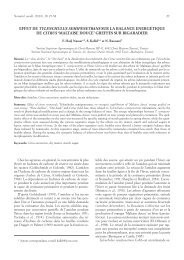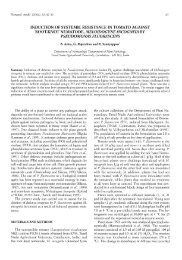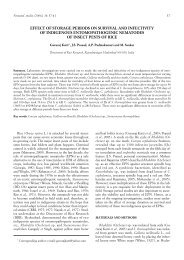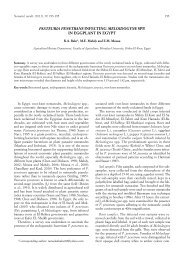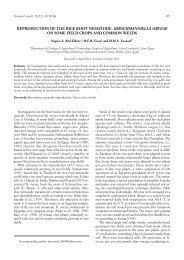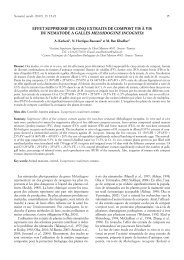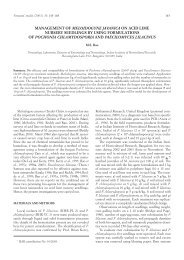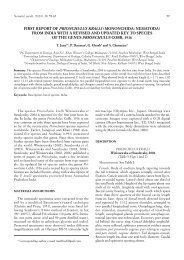temporal variation in abundance of nematodes in a banana ...
temporal variation in abundance of nematodes in a banana ...
temporal variation in abundance of nematodes in a banana ...
Create successful ePaper yourself
Turn your PDF publications into a flip-book with our unique Google optimized e-Paper software.
02 Gantait_9 28-06-2011 11:39 Pag<strong>in</strong>a 9<br />
Nematol. medit. (2011), 39: 9-15 9<br />
TEMPORAL VARIATION IN ABUNDANCE OF NEMATODES<br />
IN A BANANA PLANTATION OF WEST BENGAL, INDIA<br />
V.V. Gantait 1 *, T. Bhattacharya ** and A. Chatterjee *<br />
*<br />
Nemathelm<strong>in</strong>thes Section, Zoological Survey <strong>of</strong> India, M-Block, New Alipur, Kolkata-700053, West Bengal, India<br />
**<br />
Department <strong>of</strong> Zoology, Vidyasagar University, Med<strong>in</strong>ipur-721102, Paschim Med<strong>in</strong>ipur, West Bengal, India<br />
Summary. An ecological <strong>in</strong>vestigation was undertaken <strong>in</strong> a <strong>banana</strong> plantation <strong>of</strong> West Bengal, India, from March 2004 to February<br />
2006 dur<strong>in</strong>g which fourteen species <strong>of</strong> soil and plant parasitic <strong>nematodes</strong> were collected and identified. Of these, eight species<br />
belonged to the order Dorylaimida and six to the order Tylenchida. They exhibited a bimodal pattern <strong>of</strong> population fluctuation<br />
with a prom<strong>in</strong>ent peak dur<strong>in</strong>g August or September and a low peak dur<strong>in</strong>g March. Likewise, there were two m<strong>in</strong>ima, one dur<strong>in</strong>g<br />
January and another <strong>in</strong> May or June. Nematode populations <strong>in</strong>creased after ra<strong>in</strong>fall but decl<strong>in</strong>ed dur<strong>in</strong>g the post-monsoon period<br />
and rema<strong>in</strong>ed at a low level dur<strong>in</strong>g w<strong>in</strong>ter. Dur<strong>in</strong>g early spr<strong>in</strong>g, populations aga<strong>in</strong> <strong>in</strong>creased but decl<strong>in</strong>ed <strong>in</strong> summer. Temporal<br />
<strong>variation</strong> <strong>of</strong> the nematode population was statistically correlated with the edaphic factors temperature, moisture, pH and organic<br />
carbon. Simple correlation analysis revealed that the <strong>abundance</strong>s <strong>of</strong> all the species were significantly correlated with moisture and<br />
organic carbon. Soil temperature was significantly correlated with the <strong>abundance</strong> <strong>of</strong> only three species. Soil pH was negatively and<br />
significantly correlated with that <strong>of</strong> all the species. Multiple regression revealed that all the edaphic factors had a significant <strong>in</strong>fluence<br />
on the <strong>abundance</strong> <strong>of</strong> all the nematode species, except two viz., Laimydorus siddiqii and Pratylenchus c<strong>of</strong>feae. Canonical Correspondence<br />
Analysis further proved this f<strong>in</strong>d<strong>in</strong>g.<br />
Key words: Abundance, <strong>banana</strong>, Dorylaimida, edaphic factors, <strong>nematodes</strong>, Tylenchida.<br />
Banana is an economically important crop that is extensively<br />
cultivated <strong>in</strong> tropical and subtropical countries<br />
(Gowen et al., 2005). It is one <strong>of</strong> the major fruit crops<br />
form<strong>in</strong>g an important item <strong>in</strong> the diet <strong>of</strong> millions <strong>of</strong> people<br />
across the globe (Harish and Nanje Gowda, 2001).<br />
India is the largest <strong>banana</strong> produc<strong>in</strong>g country <strong>of</strong> the<br />
world (Devi et al., 2007), with 332.2 thousand hectares<br />
and an annual production <strong>of</strong> 3,633 thousand tonnes<br />
(Jonathan and Rajendran, 2003). West Bengal is the second<br />
largest <strong>banana</strong> produc<strong>in</strong>g State <strong>of</strong> India, with its<br />
25.73 thousand hectares and a total production <strong>of</strong> 502.1<br />
thousand tonnes per annum.<br />
Nematodes are one <strong>of</strong> the major limit<strong>in</strong>g factors <strong>in</strong><br />
<strong>banana</strong> production. Tylenchids have been recognized as<br />
a major constra<strong>in</strong>t <strong>in</strong> <strong>banana</strong> production and are responsible<br />
for serious yield losses (Sundararaju, 2006).<br />
Dorylaimids act as vectors <strong>of</strong> various fungal and bacterial<br />
diseases <strong>of</strong> this important crop (Khan, 2006). Thus,<br />
dorylaimids and tylenchids have considerable direct and<br />
<strong>in</strong>direct effects on this valuable fruit crop. Information<br />
on population structure is important <strong>in</strong> the study <strong>of</strong> the<br />
plant-nematode relationship (Oostenbr<strong>in</strong>k, 1966), for<br />
the development <strong>of</strong> an effective management schedule<br />
and advisory service (Barker and Nusbaum, 1971; Barker<br />
and Campbell, 1981; Chawla and Mittal, 1995).<br />
Edaphic factors, such as temperature, moisture, pH and<br />
organic carbon content <strong>of</strong> soil greatly <strong>in</strong>fluence the nematode<br />
population (Jones et al., 1969; Korthals et al.,<br />
1<br />
Correspond<strong>in</strong>g author: v.gantait@rediffmail.com<br />
1996; Bilgrami et al. 2003). Therefore, an <strong>in</strong>vestigation<br />
was undertaken from March 2004 to February 2006 to<br />
ascerta<strong>in</strong> <strong>temporal</strong> <strong>variation</strong> <strong>of</strong> <strong>abundance</strong> <strong>of</strong> dorylaimid<br />
and tylenchid <strong>nematodes</strong> <strong>in</strong> relation to different edaphic<br />
factors <strong>in</strong> a <strong>banana</strong> plantation <strong>of</strong> West Bengal, India, to<br />
provide a valuable data base for the development <strong>of</strong> effective<br />
management schedules and advisory services <strong>in</strong><br />
the future and thereby <strong>in</strong>crease production <strong>of</strong> this valuable<br />
fruit crop.<br />
MATERIALS AND METHODS<br />
For the present study, a plot <strong>of</strong> 15 m × 10 m was selected<br />
<strong>in</strong> a <strong>banana</strong> (Musa paradisiaca L. cv. Kanthali)<br />
plantation <strong>in</strong> Sabang block under Paschim Med<strong>in</strong>ipur<br />
district (22º57’10”-21º36’35” N, 88º12’80”-86º35’50”<br />
E) <strong>of</strong> West Bengal, India. For sampl<strong>in</strong>g, five spots, separated<br />
by equal distances, were fixed <strong>in</strong> the plot. A rhizospheric<br />
soil sample <strong>of</strong> 250 g was taken from each<br />
spot, each at a distance <strong>of</strong> about 25 cm from the ma<strong>in</strong><br />
bole <strong>of</strong> a <strong>banana</strong> plant. A root sample <strong>of</strong> 5 g was also<br />
taken from the same plant at the same spot. Thus five<br />
soil and five root samples were collected from the plot<br />
on each sampl<strong>in</strong>g occasion. The samples were collected<br />
dur<strong>in</strong>g the first week <strong>of</strong> every month, preferably on the<br />
first Sunday, from March 2004 to February 2006. Soil<br />
temperature was measured by a soil thermometer, and<br />
soil pH and moisture were estimated by a soil pH and<br />
moisture meter, Model DM-15, Takemura Electric<br />
Works Ltd., Tokyo, Japan. Organic carbon content <strong>of</strong><br />
soil was determ<strong>in</strong>ed <strong>in</strong> the laboratory follow<strong>in</strong>g Walkley
02 Gantait_9 28-06-2011 11:39 Pag<strong>in</strong>a 10<br />
10<br />
and Black’s rapid titration method (Walkley and Black,<br />
1947). Bars on the graphs <strong>of</strong> <strong>temporal</strong> <strong>variation</strong> <strong>in</strong> soil<br />
pH (Fig. 3) and <strong>temporal</strong> <strong>variation</strong> <strong>in</strong> organic carbon<br />
content <strong>of</strong> soil (Fig. 4) are represent<strong>in</strong>g the SE values <strong>of</strong><br />
the edaphic factors.<br />
Nematodes were extracted from soil by Cobb’s siev<strong>in</strong>g<br />
technique (Cobb, 1918) and from the roots us<strong>in</strong>g<br />
the mechanical maceration technique (Reddy, 1983).<br />
They were cleaned us<strong>in</strong>g the modified Baermann’s funnel<br />
technique (Christie and Perry, 1951) before count<strong>in</strong>g<br />
<strong>in</strong> a Syracuse count<strong>in</strong>g dish under a stereoscopic<br />
b<strong>in</strong>ocular microscope. Nematodes were then processed<br />
us<strong>in</strong>g Se<strong>in</strong>horst’s slow dehydration method (Se<strong>in</strong>horst,<br />
1959). Dehydrated <strong>nematodes</strong> were mounted permanently<br />
on glass slides and identified to species level follow<strong>in</strong>g<br />
the keys <strong>of</strong> Jairajpuri and Ahmad (1992) for the<br />
order Dorylaimida and <strong>of</strong> Siddiqi (2000) for the order<br />
Tylenchida. Specimens were deposited <strong>in</strong> the National<br />
Zoological Collections <strong>of</strong> the Zoological Survey <strong>of</strong> India,<br />
Kolkata, West Bengal, India.<br />
Time-series analysis <strong>of</strong> the edaphic factors, simple<br />
correlation and multiple regression analyses between<br />
the edaphic factors and <strong>abundance</strong> <strong>of</strong> nematode species<br />
were done us<strong>in</strong>g STATISTICA version 7.0 (StatS<strong>of</strong>t,<br />
Inc., 2007). Correlations between the <strong>abundance</strong> <strong>of</strong><br />
species and the measured set <strong>of</strong> environmental variables<br />
were analyzed with Canonical Correspondence Analysis<br />
(CCA) on non-transformed data. CCA is a direct gradient<br />
analysis technique, done us<strong>in</strong>g the CANOCO program<br />
v 4.53 (Ter Braak, 1988). Eigen value <strong>in</strong> the Ord<strong>in</strong>ation<br />
diagram based on Canonical Correspondence<br />
Analysis (Fig. 7) is a special set <strong>of</strong> scalars associated<br />
with a l<strong>in</strong>ear system <strong>of</strong> equation (i.e. a matrix equation)<br />
that is sometime also known as characteristic root or<br />
characteristic value which is ultimately represented as<br />
an <strong>in</strong>terpret<strong>in</strong>g value correspond<strong>in</strong>g to its eigenvector <strong>in</strong><br />
a multivariate analysis (i.e. CCA). Consider<strong>in</strong>g this value,<br />
it is predicted that the change under consideration<br />
may be accepted or rejected based on its P-value.<br />
RESULTS<br />
Dur<strong>in</strong>g the study, the soil temperature ranged from<br />
17 °C (January, 2005) to 36 °C (June, 2005). From April<br />
to October, the temperature was high and <strong>in</strong> the range<br />
31-36 °C; while from November to March it was lower<br />
(17-28 °C). After October, the temperature decl<strong>in</strong>ed<br />
and reached the m<strong>in</strong>imum level <strong>of</strong> 17-19 °C dur<strong>in</strong>g December<br />
and January. Thereafter, it <strong>in</strong>creased and<br />
reached the maximum level (35 °C-36 °C) dur<strong>in</strong>g May<br />
and June (Fig. 1). Soil moisture content varied from<br />
18.0% (January, 2005) to 35% (August, 2004); it rema<strong>in</strong>ed<br />
at a high level dur<strong>in</strong>g July/August and then decl<strong>in</strong>ed<br />
until January. Thereafter, it <strong>in</strong>creased until March<br />
and then decl<strong>in</strong>ed aga<strong>in</strong> by May (Fig. 2). Soil pH ranged<br />
from 5.2 (August, 2004) to 7.4 (January, 2005). The soil<br />
was mostly acidic <strong>in</strong> nature (5.2-6.9) dur<strong>in</strong>g almost the<br />
Fig. 1. Temporal <strong>variation</strong> <strong>in</strong> soil temperature.<br />
Fig. 2. Temporal <strong>variation</strong> <strong>in</strong> soil moisture.<br />
Fig. 3. Temporal <strong>variation</strong> <strong>in</strong> soil pH.<br />
Fig. 4. Temporal <strong>variation</strong> <strong>in</strong> organic carbon content <strong>of</strong> soil.
02 Gantait_9 28-06-2011 11:39 Pag<strong>in</strong>a 11<br />
Gantait et al. 11<br />
Fig. 5. Population fluctuation <strong>of</strong> dorylaimid <strong>nematodes</strong>.<br />
Fig. 6. Population fluctuation <strong>of</strong> tylenchid <strong>nematodes</strong>.<br />
entire study period, except <strong>in</strong> January, when it was alkal<strong>in</strong>e<br />
(7.3-7.4). Dur<strong>in</strong>g monsoon and post-monsoon periods,<br />
the soil was highly acidic, but was only slightly<br />
acidic <strong>in</strong> the other months (Fig. 3). Organic carbon content<br />
<strong>of</strong> soil varied from 1.82% (June, 2004) to 3.42%<br />
(July, 2005), with the greatest level be<strong>in</strong>g observed dur<strong>in</strong>g<br />
July/August. Thereafter, it decl<strong>in</strong>ed until January<br />
and then <strong>in</strong>creased aga<strong>in</strong> to March (Fig. 4).<br />
Fourteen species <strong>of</strong> soil and plant parasitic <strong>nematodes</strong><br />
were collected and identified. Of these, eight<br />
species belonged to the order Dorylaimida and six<br />
species to the order Tylenchida (Table I). Among the<br />
dorylaimids five species, Dorylaimus <strong>in</strong>novatus Jana et<br />
Baqri, Prodorylaimus sukuli Baksi et Baqri, Aporcelaimellus<br />
subhasi Gantait, Bhattacharya and Chatterjee,<br />
Oriverutus lobatus Siddiqi and Paract<strong>in</strong>olaimus aruprus<br />
Khan, Ahmad et Jairajpuri, were found all the year<br />
round and <strong>in</strong> large numbers. The rema<strong>in</strong><strong>in</strong>g three<br />
species, Laimydorus siddiqii Baqri et Jana, Thonus<br />
garhwaliensis Ahmad, Nath et Haider and Promumtazium<br />
elongatum Ahmad et Jairajpuri, were found dur<strong>in</strong>g<br />
some months <strong>of</strong> the year, and their numbers were very<br />
low. Among the tylenchids, four species, Hoplolaimus<br />
(Basirolaimus) <strong>in</strong>dicus Sher, Helicotylenchus crenacauda<br />
Sher, Rotylenchulus reniformis L<strong>in</strong>ford et Oliveira and<br />
Tylenchorhynchus c<strong>of</strong>feae Siddiqi et Basir, were found <strong>in</strong><br />
large numbers all the year round. The rema<strong>in</strong><strong>in</strong>g two<br />
species, Pratylenchus c<strong>of</strong>feae (Zimmermann) Filipjev et<br />
Schuurmans Stekhoven and Meloidogyne <strong>in</strong>cognita (K<strong>of</strong>oid<br />
et White) Chitwood, were found occasionally <strong>in</strong><br />
scant numbers.<br />
All the nematode species encountered exhibited a bimodal<br />
pattern <strong>of</strong> population fluctuation with a prom<strong>in</strong>ent<br />
peak dur<strong>in</strong>g August or September and a low peak<br />
dur<strong>in</strong>g March each year (Figs 5 and 6). Likewise, there<br />
were two m<strong>in</strong>ima, one dur<strong>in</strong>g January and another <strong>in</strong><br />
May or June. The populations <strong>in</strong>creased after ra<strong>in</strong>fall<br />
but decl<strong>in</strong>ed dur<strong>in</strong>g the post-monsoon period and rema<strong>in</strong>ed<br />
at a low level dur<strong>in</strong>g w<strong>in</strong>ter. Dur<strong>in</strong>g early<br />
spr<strong>in</strong>g, populations aga<strong>in</strong> <strong>in</strong>creased but summer aga<strong>in</strong><br />
caused a decl<strong>in</strong>e <strong>in</strong> their sizes.<br />
Simple correlation analysis revealed that the <strong>abundance</strong>s<br />
<strong>of</strong> all the species were significantly correlated<br />
with soil moisture and organic carbon contents, whereas<br />
only H. (B.) <strong>in</strong>dicus, H. crenacauda and T. c<strong>of</strong>feae were<br />
significantly correlated with soil temperature. Contrarily<br />
to these f<strong>in</strong>d<strong>in</strong>gs, the soil pH was negatively and significantly<br />
correlated with <strong>abundance</strong>s <strong>of</strong> all nematode<br />
species (Table II). However, multiple regression revealed<br />
that all the edaphic factors studied had a significant<br />
<strong>in</strong>fluence on the <strong>abundance</strong> <strong>of</strong> all the species except<br />
L. siddiqii and P. c<strong>of</strong>feae (Table III). Canonical<br />
Correspondence Analysis (CCA) further proved this<br />
f<strong>in</strong>d<strong>in</strong>g. The CCA diagram clearly shows that all the environmental<br />
variables had a significant <strong>in</strong>fluence on the<br />
nematode species (Fig. 7). However, the <strong>in</strong>fluence <strong>of</strong><br />
pH is different to that <strong>of</strong> other variables.<br />
Fig. 7. Ord<strong>in</strong>ation diagram based on Canonical Correspondence<br />
Analysis. Test <strong>of</strong> significance <strong>of</strong> first canonical axis:<br />
Eigen value = 0.014; F-ratio = 7.308; P-value = 0.002. Test <strong>of</strong><br />
significance <strong>of</strong> all canonical axes: Eigen value = 0.021. F-ratio<br />
= 3.367; P-value = 0.002.
02 Gantait_9 28-06-2011 11:39 Pag<strong>in</strong>a 12<br />
12<br />
DISCUSSION<br />
Our <strong>in</strong>vestigation shows that <strong>abundance</strong> <strong>of</strong> all the nematode<br />
species was low <strong>in</strong> December and January due<br />
to low temperature and low moisture content <strong>of</strong> the<br />
soil, similar to the f<strong>in</strong>d<strong>in</strong>gs <strong>of</strong> Khan et al. (1971) and<br />
Dwivedi and Misra (1990). Khan and Sharma (1990)<br />
and Pandey (1999) reported that, <strong>in</strong> general, the nematode<br />
population was low <strong>in</strong> December, which may be<br />
due to low temperature and moisture. As the temperature<br />
<strong>in</strong>creased <strong>in</strong> March, the nematode populations<br />
tended to <strong>in</strong>crease. Boag (1980) stated that temperature<br />
<strong>in</strong>fluences the feed<strong>in</strong>g rate <strong>of</strong> <strong>nematodes</strong>, their reproduction,<br />
etc. and, therefore, populations <strong>in</strong>crease as the<br />
temperature beg<strong>in</strong>s to rise. This trend reversed and the<br />
<strong>abundance</strong> <strong>of</strong> <strong>nematodes</strong> decl<strong>in</strong>ed <strong>in</strong> summer (May/<br />
June). This decl<strong>in</strong>e <strong>in</strong> <strong>abundance</strong> was associated with<br />
high temperature and low soil moisture content. This<br />
agrees with f<strong>in</strong>d<strong>in</strong>gs by Griff<strong>in</strong> and Darl<strong>in</strong>g (1964). Our<br />
f<strong>in</strong>d<strong>in</strong>gs also support observations by Ahmad and Jairajpuri<br />
(1982) and Azmi (1995). But Pandey (1999) reported<br />
that the nematode population was greatest <strong>in</strong><br />
April-May. Dur<strong>in</strong>g periods <strong>of</strong> ra<strong>in</strong> the soil moisture content<br />
gradually <strong>in</strong>creases, so reduc<strong>in</strong>g the temperature <strong>of</strong><br />
the soil. Thus, it can result <strong>in</strong> <strong>in</strong>creased population<br />
build-up. Nematode <strong>abundance</strong> <strong>in</strong> our plot <strong>in</strong>creased<br />
from July onwards, reach<strong>in</strong>g a peak <strong>in</strong> August/September.<br />
This might be due to optimum moisture conditions<br />
<strong>of</strong> the soil and moderate temperature, as observed by<br />
Azmi (1995). On the contrary, Mani and H<strong>in</strong>ai (1996)<br />
observed that <strong>in</strong> the Sultanate <strong>of</strong> Oman population densities<br />
<strong>of</strong> <strong>nematodes</strong>, <strong>in</strong> both soil and roots <strong>of</strong> <strong>banana</strong>,<br />
decl<strong>in</strong>ed sharply from May onwards and reached their<br />
lowest levels dur<strong>in</strong>g June-July, co<strong>in</strong>cid<strong>in</strong>g with the highest<br />
soil temperature. As <strong>in</strong> the present study, Nath et al.<br />
(1998) also showed that favourable conditions for<br />
growth and reproduction <strong>of</strong> different species <strong>of</strong> plant<br />
parasitic <strong>nematodes</strong> prevailed dur<strong>in</strong>g pre-monsoon<br />
(March) and post-monsoon (October) periods. However,<br />
this is <strong>in</strong> contrast with the observations <strong>of</strong> Kable and<br />
Mai (1968), Robb<strong>in</strong>s and Barker (1974), and S<strong>in</strong>gh and<br />
Sharma (1995). These authors found that high soil<br />
moisture levels exert a negative pressure on the growth<br />
and reproduction <strong>of</strong> <strong>nematodes</strong>. In our study, from the<br />
post-monsoon period onward the nematode population<br />
decreased. This decl<strong>in</strong>e <strong>in</strong> <strong>abundance</strong> followed the decl<strong>in</strong>e<br />
<strong>in</strong> soil temperature and moisture content, as observed<br />
also by Mukherjee and Dasgupta (1983). Thus,<br />
the present study suggested that soil temperature and<br />
moisture favoured nematode population growth but<br />
that the extremes <strong>of</strong> both had an adverse effect on nematode<br />
populations.<br />
The soil <strong>of</strong> the study field was mostly acidic dur<strong>in</strong>g<br />
almost the entire study period, except <strong>in</strong> January, when<br />
it was slightly alkal<strong>in</strong>e. The maximum <strong>abundance</strong> <strong>of</strong> <strong>nematodes</strong><br />
was found when the pH was <strong>in</strong> the range 5.3-<br />
6.4 and was m<strong>in</strong>imum <strong>in</strong> January. This <strong>in</strong>dicates that nematode<br />
populations <strong>in</strong>creased <strong>in</strong> acidic soil and decreased<br />
<strong>in</strong> alkal<strong>in</strong>e soil. A similar f<strong>in</strong>d<strong>in</strong>g was also reported<br />
by Szczygiel et al. (1983). Das et al. (1990) observed<br />
<strong>in</strong>creased biotic activities <strong>of</strong> <strong>nematodes</strong> <strong>in</strong> acidic<br />
soil and rapid decl<strong>in</strong>e <strong>in</strong> alkal<strong>in</strong>e soil. In other studies<br />
Choudhury and Phukan (1995) found that when soil<br />
pH <strong>in</strong>creases above 6.9, the density <strong>of</strong> most <strong>of</strong> the <strong>nematodes</strong><br />
decreases; while Bilgrami et al. (2003) reported<br />
that <strong>nematodes</strong> preferred less alkal<strong>in</strong>e pH. Ahmad and<br />
Table I. Nematode species encountered dur<strong>in</strong>g the study.<br />
Sl.<br />
No.<br />
ORDER : DORYLAIMIDA<br />
Name <strong>of</strong> species<br />
Abbreviation <strong>of</strong> species<br />
1. Dorylaimus <strong>in</strong>novatus Jana et Baqri, 1982 Dor <strong>in</strong>n<br />
2. Prodorylaimus sukuli Baksi et Baqri, 1985 Pro suk<br />
3. Laimydorus siddiqii Baqri et Jana, 1982 Lai sid<br />
4. Aporcelaimellus subhasi Gantait et al., 2006 Apo sub<br />
5. Thonus garhwaliensis Ahmad et al., 1986 Tho gar<br />
6. Oriverutus lobatus Siddiqi, 1971 Ori lob<br />
7. Paract<strong>in</strong>olaimus aruprus Khan et al., 1994 Par aru<br />
8. Promumtazium elongatum Ahmad et Jairajpuri, 1984 Pro elo<br />
ORDER : TYLENCHIDA<br />
9. Hoplolaimus (Basirolaimus) <strong>in</strong>dicus Sher, 1963 Hop <strong>in</strong>d<br />
10. Helicotylenchus crenacauda Sher, 1966 Hel cre<br />
11. Rotylenchulus reniformis L<strong>in</strong>ford et Oliveira, 1940 Rot ren<br />
12. Pratylenchus c<strong>of</strong>feae (Zimmermann, 1898) Filipjev et Schuurmans Stekhoven, 1941 Pra c<strong>of</strong><br />
13. Meloidogyne <strong>in</strong>cognita (K<strong>of</strong>oid et White, 1919) Chitwood, 1949 Mel <strong>in</strong>c<br />
14. Tylenchorhynchus c<strong>of</strong>feae Siddiqi et Basir, 1959 Tyl c<strong>of</strong>
02 Gantait_9 28-06-2011 11:39 Pag<strong>in</strong>a 13<br />
Gantait et al. 13<br />
Table II. Simple correlation between edaphic factors and <strong>abundance</strong> <strong>of</strong> nematode species.<br />
Sl. Sl. No. No. Nematode species<br />
Temperature Moisture pH<br />
Organic carbon<br />
(Abbr.)<br />
content<br />
content<br />
1. Dor <strong>in</strong>n 0.418 0.763 *** - 0.694 *** 0.639 ***<br />
2. Pro suk 0.391 0.874 *** - 0.689 *** 0.807 ***<br />
3. Lai sid 0.148 0.548 ** - 0.518 ** 0.509 *<br />
4. Apo sub 0.330 0.874 *** - 0.721 *** 0.839 ***<br />
5. Tho gar 0.190 0.636 ** - 0.551 ** 0.728 ***<br />
6. Ori lob 0.190 0.711 *** - 0.616 ** 0.710 ***<br />
7. Par aru 0.328 0.871 *** - 0.729 *** 0.844 ***<br />
8. Pro elo 0.161 0.644 *** -0.507 * 0.679 ***<br />
9. Hop <strong>in</strong>d 0.677 *** 0.848 *** - 0.599 ** 0.657 ***<br />
10. Hel cre 0.570 ** 0.766 *** - 0.507 * 0.693 ***<br />
11. Rot ren 0.392 0.801 *** - 0.672 *** 0.719 ***<br />
12. Pra c<strong>of</strong> 0.121 0.538 ** - 0.450 * 0.494 *<br />
13. Mel <strong>in</strong>c 0.340 0.666 *** - 0.429 * 0.607 **<br />
14. Tyl c<strong>of</strong> 0.497 * 0.847 *** - 0.605 ** 0.772 ***<br />
*<br />
= P ≤ 0.05, ** = P ≤ 0.01, *** = P ≤ 0.001<br />
Jairajpuri (1982) also reported that mononchid <strong>nematodes</strong><br />
generally prefer soil pH between 5 and 6 and that<br />
they cannot survive <strong>in</strong> highly acidic or alkal<strong>in</strong>e media.<br />
While <strong>in</strong>vestigat<strong>in</strong>g the <strong>variation</strong> <strong>of</strong> nematode population<br />
with organic carbon content <strong>of</strong> the soil, it was<br />
found that as the organic carbon content <strong>in</strong>creased the<br />
<strong>abundance</strong> <strong>of</strong> <strong>nematodes</strong> also <strong>in</strong>creased, thus agree<strong>in</strong>g<br />
with f<strong>in</strong>d<strong>in</strong>gs by Krnjaic and Krnjaic (1974), Mishra and<br />
Prasad (1974), Abrar et al. (1974), Szczygiel and Zepp<br />
(1983), and Bilgrami et al. (2003).<br />
Our attempt to correlate the <strong>temporal</strong> <strong>variation</strong> <strong>of</strong><br />
the nematode populations with the edaphic factors revealed<br />
that soil moisture content and organic carbon<br />
content were positively correlated and pH was negatively<br />
correlated with all the species. Temperature exhibited<br />
a positive correlation with only three species <strong>of</strong> phytophagous<br />
<strong>nematodes</strong> (Table II). Mani and H<strong>in</strong>ai (1996)<br />
reported significant negative correlation between mean<br />
soil temperature and nematode population <strong>in</strong> soil and<br />
roots <strong>of</strong> <strong>banana</strong> <strong>in</strong> the Sultanate <strong>of</strong> Oman. Bell and Watson<br />
(2001) observed a positive correlation between temperature<br />
and population <strong>of</strong> Paratylenchus nanus Cobb.<br />
Gantait et al. (2006) also found a positive correlation<br />
between soil temperature and populations <strong>of</strong> R. reniformis<br />
L<strong>in</strong>ford et Oliveira, T. c<strong>of</strong>feae Siddiqi et Basir, H.<br />
crenacauda Sher and H. (B.) <strong>in</strong>dicus Sher. Khan and<br />
Sharma (1990) observed that soil moisture was not significantly<br />
correlated with population build-up <strong>of</strong> M.<br />
<strong>in</strong>cognita, Tylenchorhynchus mashhoodi Siddiqi et Basir,<br />
Pratylenchus pratensis (de Man) Filipjev and Helicotylenchus<br />
dihystera (Cobb) Sher. Bell et Watson (2001) also<br />
observed a negative correlation between the population<br />
<strong>of</strong> P. nanus and soil moisture. Bilgrami et al. (2003),<br />
however, reported a positive correlation <strong>of</strong> nematode<br />
population with soil moisture <strong>in</strong> different localities <strong>of</strong><br />
Shenyang Municipality, Northeast Ch<strong>in</strong>a. Gantait et al.<br />
(2006) observed positive correlation between the population<br />
<strong>of</strong> R. reniformis, T. c<strong>of</strong>feae, H. crenacauda and H.<br />
(B.) <strong>in</strong>dicus with soil moisture. As <strong>in</strong> the present study,<br />
Smith and Wallace (1976), Das et al. (1990), Choudhury<br />
and Phukan (1995) and Gantait et al. (2006) reported<br />
that the <strong>abundance</strong> <strong>of</strong> <strong>nematodes</strong> was negatively correlated<br />
with the soil pH. With reference to organic carbon,<br />
Mishra and Prasad (1974) reported that the population<br />
<strong>of</strong> H. (B.) <strong>in</strong>dicus <strong>in</strong>creased with <strong>in</strong>crease <strong>in</strong> organic<br />
carbon content <strong>of</strong> the soil, and Szczygiel and<br />
Zepp (1983) found a positive correlation between the<br />
organic carbon content <strong>of</strong> soil and the population <strong>of</strong><br />
Table III. Multiple regression between edaphic factors and<br />
<strong>abundance</strong> <strong>of</strong> nematode species.<br />
Sl. Nematode species<br />
R 2<br />
F<br />
No. (Abbr.)<br />
1. Dor <strong>in</strong>n 0.615 7.598 *<br />
2. Pro suk 0.791 18.005 *<br />
3. Lai sid 0.366 2.743<br />
4. Apo sub 0.824 22.307 *<br />
5. Tho gar 0.546 5.709 *<br />
6. Ori lob 0.592 6.903 *<br />
7. Par aru 0.827 22.748 *<br />
8. Pro elo 0.496 4.667 *<br />
9. Hop <strong>in</strong>d 0.793 18.237 *<br />
10. Hel cre 0.708 11.493 *<br />
11. Rot ren 0.663 9.364 *<br />
12. Pra c<strong>of</strong> 0.347 2.522<br />
13. Mel <strong>in</strong>c 0.469 4.192 *<br />
14. Tyl c<strong>of</strong> 0.758 14.861 *<br />
* = P ≤ 0.05
02 Gantait_9 28-06-2011 11:39 Pag<strong>in</strong>a 14<br />
14<br />
Pratylenchus penetrans (Cobb) Filipjev et Schuurmans<br />
Stekhoven and Longidorus elongatus (de Man) Thorne<br />
et Swanger. Hazra (1994) observed that the organic carbon<br />
content <strong>of</strong> the soil exhibited a strong positive correlation<br />
with the nematode population <strong>in</strong> Schirmacher<br />
Oasis, Antarctica. Positive correlations <strong>of</strong> nematode<br />
population with the organic carbon <strong>of</strong> soil were also observed<br />
by Bilgrami et al. (2003) and Gantait et al.<br />
(2006).<br />
It has been a common practice among soil zoologists<br />
to correlate various edaphic factors with the fluctuation<br />
<strong>of</strong> <strong>abundance</strong> <strong>of</strong> <strong>nematodes</strong> us<strong>in</strong>g simple correlation.<br />
Most <strong>of</strong> these attempts have provided conflict<strong>in</strong>g conclusions.<br />
So <strong>in</strong> the present study, beside simple correlation,<br />
multiple regression has also been attempted. Multiple<br />
regression revealed that all the edaphic factors<br />
studied had a significant <strong>in</strong>fluence on the <strong>abundance</strong> <strong>of</strong><br />
all the nematode species except two. Canonical Correspondence<br />
Analysis further showed that all the edaphic<br />
factors had a significant <strong>in</strong>fluence on the nematode<br />
species (P = 0.002). However, the soil pH showed the<br />
<strong>in</strong>fluence <strong>in</strong> a different way to the other factors. No<br />
such study on <strong>nematodes</strong> is available <strong>in</strong> this regard for<br />
comparison.<br />
ACKNOWLEDGEMENTTS<br />
The authors are thankful to the Director <strong>of</strong> the Zoological<br />
Survey <strong>of</strong> India, Kolkata, and the Vice Chancellor,<br />
Vidyasagar University, Paschim Med<strong>in</strong>ipur for provid<strong>in</strong>g<br />
laboratory and other facilities.<br />
LITERATURE CITED<br />
Abrar M., Khan M., Mashkoor A. and Ahmad R., 1974.<br />
Mechanism <strong>of</strong> the control <strong>of</strong> plant parasitic <strong>nematodes</strong> as a<br />
result <strong>of</strong> the application <strong>of</strong> oil cakes to the soil. Indian Journal<br />
<strong>of</strong> Nematology, 4: 93-96.<br />
Ahmad N. and Jairajpuri M.S., 1982. Effect <strong>of</strong> pH, m<strong>in</strong>eral<br />
salts and fatty acids on the predatory nematode, Prahadronchus<br />
shakili (Jairajpuri, 1969) Mulvey, 1978. Indian<br />
Journal <strong>of</strong> Nematology, 12: 22-30.<br />
Azmi M.I., 1995. Seasonal population fluctuations behaviour<br />
<strong>of</strong> plant parasitic <strong>nematodes</strong> <strong>in</strong> Caribbean Stylo. Indian<br />
Journal <strong>of</strong> Nematology, 25: 168-173.<br />
Barker K.R. and Campbell C.L., 1981. Sampl<strong>in</strong>g nematode<br />
populations. Pp. 451-473. In: Plant Parasitic Nematodes,<br />
Vol. III (Zuckerman B.M. and Rhode R.A., eds). Academic<br />
Press, New York, USA.<br />
Barker K.R. and Nusbaum C.J., 1971. Diagnostic and advisory<br />
programmes. Pp. 281-301. In: Plant Parasitic Nematodes,<br />
Vol. I (Zuckerman B.M., Mai W.F. and Rhode R.A.,<br />
eds). Academic Press, New York, USA.<br />
Bell N.L. and Watson R.N., 2001. Population dynamics <strong>of</strong><br />
Pratylenchus nanus <strong>in</strong> soil under pasture: 1. Aggregation<br />
and abiotic factors. Nematology, 3: 187-197.<br />
Bilgrami A.L., Liang W. and Li Q., 2003. Generic diversity,<br />
population structure and community ecology <strong>of</strong> plant and<br />
soil <strong>nematodes</strong>. International Journal <strong>of</strong> Nematology, 13:<br />
104-117.<br />
Boag B., 1980. Effects <strong>of</strong> temperature on rate <strong>of</strong> feed<strong>in</strong>g <strong>of</strong> the<br />
plant-parasitic <strong>nematodes</strong>, Rotylenchulus robustus,<br />
Xiph<strong>in</strong>ema diversicaudatum and Hemicycliophora conida.<br />
Journal <strong>of</strong> Nematology, 12: 193-195.<br />
Chawla M.L. and Mittal A., 1995. Nematode population dynamics<br />
and model<strong>in</strong>g. Pp. 285-295. In: Nematode Pest<br />
Management – an Appraisal <strong>of</strong> Eco-friendly Approaches<br />
(Swarup G., Dasgupta D.R. and Gill J.S., eds). Nematological<br />
Society <strong>of</strong> India, New Delhi, India.<br />
Chowdhury B.N. and Phukan P.N., 1995. Study on the <strong>variation</strong>s<br />
<strong>of</strong> certa<strong>in</strong> plant parasitic <strong>nematodes</strong> at different levels<br />
<strong>of</strong> soil pH. Indian Journal <strong>of</strong> Nematology, 25: 202-203.<br />
Christie J.R. and Perry V.G., 1951. Remov<strong>in</strong>g <strong>nematodes</strong><br />
from soil. Proceed<strong>in</strong>gs <strong>of</strong> the Helm<strong>in</strong>thological Society <strong>of</strong><br />
Wash<strong>in</strong>gton, 18: 106-108.<br />
Cobb N.A., 1918. Estimat<strong>in</strong>g the nema population <strong>of</strong> the soil.<br />
Agricultural Technology Circular I. Bureau <strong>of</strong> Plant Industry,<br />
Department <strong>of</strong> Agriculture, United States, 48 pp.<br />
Das B.K., Sarkar J., Sarkar S., Das N.K., Ray I. and Sen S.K.,<br />
1990. Correlation between some edaphic factors and<br />
Meloidogyne <strong>in</strong>cognita <strong>in</strong>festation on mulberry <strong>in</strong> Malda,<br />
West Bengal. Indian Journal <strong>of</strong> Nematology, 20: 91-94.<br />
Devi A.N., Ponnuswami V., Sundararaju P., Soorianathasundaram<br />
K., Sathiamoorthy S., Uma S. and Bergh I.V.D.,<br />
2007. Mechanism <strong>of</strong> resistance <strong>in</strong> <strong>banana</strong> cultivars aga<strong>in</strong>st<br />
root lesion nematode Pratylenchus c<strong>of</strong>feae. Indian Journal<br />
<strong>of</strong> Nematology, 37: 138-144.<br />
Dwivedi B.K. and Misra S.L., 1990. Environmental correlates<br />
to the population dynamics <strong>of</strong> plant <strong>nematodes</strong> around<br />
root zones <strong>of</strong> Citrus s<strong>in</strong>ensis at Allahabad. Current Nematology,<br />
1: 25-30.<br />
Gantait V.V., Bhattacharya T. and Chatterjee A., 2006. Fluctuation<br />
<strong>of</strong> nematode population associated with <strong>banana</strong><br />
plantation <strong>in</strong> Paschim Med<strong>in</strong>ipur district, West Bengal, India.<br />
Indian Journal <strong>of</strong> Nematology, 36: 223-225.<br />
Gowen S.R., Queneherve P. and R. Foga<strong>in</strong>, 2005. Nematode<br />
parasites <strong>of</strong> <strong>banana</strong>s and planta<strong>in</strong>s. Pp. 611-643. In: Plant<br />
Parasitic Nematodes <strong>in</strong> Subtropical and Tropical Agriculture<br />
– Second Edition (Luc M., Sikora R.A. and Bridge J.,<br />
eds). CABI Publish<strong>in</strong>g, Wall<strong>in</strong>gford, England.<br />
Griff<strong>in</strong> G.D. and Darl<strong>in</strong>g H.M., 1964. An ecological study <strong>of</strong><br />
Xiph<strong>in</strong>ema americanum Cobb <strong>in</strong> an ornamental spruce<br />
nursery. Nematologica, 10: 471-479.<br />
Harish M. and Nanje Gowda D., 2001. Management <strong>of</strong> the<br />
burrow<strong>in</strong>g nematode, Radopholus similis (Cobb, 1893)<br />
Thorne, 1949 <strong>in</strong>fest<strong>in</strong>g <strong>banana</strong>. Indian Journal <strong>of</strong> Nematology,<br />
31: 23-25.<br />
Hazra A.K., 1994. A study on the population ecology <strong>of</strong> soil<br />
nematode fauna <strong>in</strong> relation to some edaphic factors <strong>in</strong><br />
Schirmacher Oasis, Antarctica. N<strong>in</strong>th Indian Expedition to<br />
Antarctica, Scientific Report. Department <strong>of</strong> Ocean Development,<br />
Technical Publication No. 6: 65-90.<br />
Jairajpuri M.S. and Ahmad W., 1992. Dorylaimida: Free-liv<strong>in</strong>g,<br />
Predaceous and Plant Parasitic Nematodes. Oxford and<br />
IBH Publish<strong>in</strong>g Company Private Limited, New Delhi, India,<br />
458 pp.<br />
Jonathan E.I. and Rajendran G., 2003. Spatial distribution <strong>of</strong>
02 Gantait_9 28-06-2011 11:39 Pag<strong>in</strong>a 15<br />
Gantait et al. 15<br />
root-knot nematode, Meloidogyne <strong>in</strong>cognita <strong>in</strong> Banana,<br />
Musa sp. Indian Journal <strong>of</strong> Nematology, 33: 47-51.<br />
Jones F.G.W., Larbey D.W. and Parrott D.M., 1969. The <strong>in</strong>fluence<br />
<strong>of</strong> soil temperature and moisture on <strong>nematodes</strong>, especially<br />
Xiph<strong>in</strong>ema, Longidorus, Trichodorus and Heterodera<br />
spp. Soil Biology and Biochemistry, 1: 153-165.<br />
Kable P.F. and Mai W.F., 1968. Influence <strong>of</strong> soil moisture on<br />
Pratylenchus penetrans. Nematologica, 14: 101-122.<br />
Khan A.M., Adhami A. and Saxena S.K., 1971. Population<br />
changes <strong>of</strong> some stylet-bear<strong>in</strong>g <strong>nematodes</strong> associated with<br />
mango (Mangifera <strong>in</strong>dica L.). Indian Journal <strong>of</strong> Nematology,<br />
1: 99-105.<br />
Khan M.R., 2006. Current options for manag<strong>in</strong>g nematode<br />
pest <strong>of</strong> crops <strong>in</strong> India. Pp. 16-50. In: Plant Nematology <strong>in</strong><br />
India (Mohilal N. and Gambhir R.K., eds). Parasitology<br />
Laboratory, Department <strong>of</strong> Life Sciences, Manipur University,<br />
Manipur, India.<br />
Khan M.L. and Sharma G.S., 1990. Effect <strong>of</strong> temperature and<br />
moisture on population fluctuation <strong>of</strong> <strong>nematodes</strong> <strong>in</strong> an apple<br />
orchard. Indian Journal <strong>of</strong> Nematology, 20: 10-13.<br />
Korthals G.W., Alexiev A.D., Lexmond T.M., Kammenga<br />
J.E. and Bongers T., 1996. Long-term effect <strong>of</strong> copper and<br />
pH on the nematode community <strong>in</strong> an agro ecosystem. Environment<br />
Toxicological Chemistry, 15: 979-985.<br />
Krnjaic D. and Krnjaic S., 1974. Influence <strong>of</strong> some factors on<br />
the distribution <strong>of</strong> <strong>nematodes</strong> <strong>in</strong> soil. Zemljistu zastita Bilja,<br />
25: 39-48.<br />
Mani A. and H<strong>in</strong>ai A., 1996. Population dynamics and control<br />
<strong>of</strong> plant parasitic <strong>nematodes</strong> on <strong>banana</strong> <strong>in</strong> the sultanate<br />
<strong>of</strong> Oman. Nematologia Mediterranea, 24: 295-299.<br />
Mishra S.D. and Prasad S.K., 1974. Effect <strong>of</strong> soil amendments<br />
on nematode and crop yields I. Oil-seed cakes, organic<br />
matter, <strong>in</strong>organic fertilizers and growth regulators on <strong>nematodes</strong><br />
associated with wheat and their residual effect on<br />
mung. Indian Journal <strong>of</strong> Nematology, 4: 1-19.<br />
Mukherjee B. and Dasgupta M.K., 1983. Community analysis<br />
<strong>of</strong> <strong>nematodes</strong> associated with <strong>banana</strong> plantations <strong>in</strong> the<br />
Hooghly District, West Bengal, India. Nematologia<br />
Mediterranea, 11: 43- 48.<br />
Nath R.C., Mukherjee B. and Dasgupta M.K., 1998. Population<br />
dynamics <strong>of</strong> plant parasitic <strong>nematodes</strong> <strong>in</strong> a p<strong>in</strong>eapple<br />
plantation <strong>of</strong> Tripura, India. International Journal <strong>of</strong> Nematology,<br />
8: 185-190.<br />
Oostenbr<strong>in</strong>k M., 1966. Major characteristics <strong>of</strong> the relation<br />
between <strong>nematodes</strong> and plants. Mededel<strong>in</strong>gen Landbouwhogeschool<br />
Wagen<strong>in</strong>gen, 66: 1046.<br />
Pandey R., 1999. Population dynamics <strong>of</strong> phyto<strong>nematodes</strong> <strong>in</strong><br />
an arable soil planted with Costus speciosus (Koeti) Sm. Indian<br />
Journal <strong>of</strong> Nematology, 29: 81-82.<br />
Reddy P.P., 1983. Plant Nematology. Agricole Publish<strong>in</strong>g<br />
Academy, New Delhi, India, 287 pp.<br />
Robb<strong>in</strong>s R.T. and Barker K.R., 1974. The effects <strong>of</strong> soil type,<br />
particle size, temperature and moisture on reproduction <strong>of</strong><br />
Belonolaimus longicaudatus. Journal <strong>of</strong> Nematology, 6: 1-6.<br />
Se<strong>in</strong>horst J.W., 1959. A rapid method for the transfer <strong>of</strong> <strong>nematodes</strong><br />
from fixative to anhydrous glycer<strong>in</strong>e. Nematologica,<br />
4: 67-69.<br />
Siddiqi M.R., 2000. Tylenchida: Parasites <strong>of</strong> Plants and Insects.<br />
CABI Publish<strong>in</strong>g, Wall<strong>in</strong>gford, U.K., 833 pp.<br />
S<strong>in</strong>gh M. and Sharma S.B., 1995. Infectivity, development<br />
and reproduction <strong>of</strong> Heterodera cajani on pigeonpea - <strong>in</strong>fluence<br />
<strong>of</strong> soil moisture and temperature. Journal <strong>of</strong> Nematology,<br />
27: 370-377.<br />
Smith A.D.M. and Wallace H.R., 1976. Fluctuation <strong>in</strong> the distribution<br />
<strong>of</strong> numbers <strong>of</strong> Helicotylenchus dihystera <strong>in</strong><br />
Kikuyu turf (Pennisetum elandest<strong>in</strong>um). Nematologica, 22:<br />
145-152.<br />
StatS<strong>of</strong>t Inc., 2007. STATISTICA (Data Analysis S<strong>of</strong>tware<br />
System), Version 7.0. www.stats<strong>of</strong>t.com.<br />
Sundararaju P., 2006. Community structure <strong>of</strong> plant parasitic<br />
<strong>nematodes</strong> <strong>in</strong> <strong>banana</strong> plantations <strong>of</strong> Andhra Pradesh, India.<br />
Indian Journal <strong>of</strong> Nematology, 36: 226-229.<br />
Szczygiel A. and Zeep A., 1983. Effect <strong>of</strong> organic matter <strong>in</strong><br />
soil on population and pathogenicity <strong>of</strong> Pratylenchus penetrans<br />
and Longidorus elongatus to strawberry plants. Zeszyty<br />
Problemowe Postepow Nauk Rolniezych, 278: 113-122.<br />
Szczygiel A., Slowik K. and Saroka A., 1983. Effect <strong>of</strong> soil pH<br />
on host-parasite relationship <strong>of</strong> three plant parasitic <strong>nematodes</strong><br />
<strong>of</strong> strawberry plants. Zeszyty Problemowe Postepow<br />
Nauk Rolniezyeh, 278: 95-104.<br />
Ter Braak C.J.F., 1988. CANOCO – a FORTRAN Program<br />
for canonical community ord<strong>in</strong>ations by (partial), (detrended),<br />
(canonical) correspondence analysis, pr<strong>in</strong>cipal<br />
components analysis and redundancy analysis. Groep<br />
Landbouw Wiskunde, Wagen<strong>in</strong>gen, The Netherlands, 95.<br />
Walkley A. and Black I.A., 1974. Chromic acid titration<br />
method for determ<strong>in</strong>ation <strong>of</strong> soil organic matter. Soil Science,<br />
63: 251-264.<br />
Accepted for publication on 18 March 2011.





